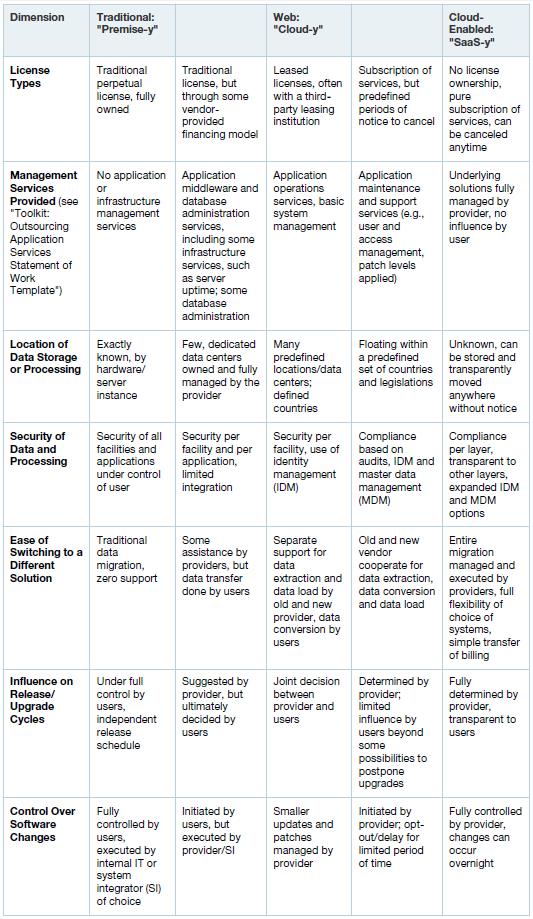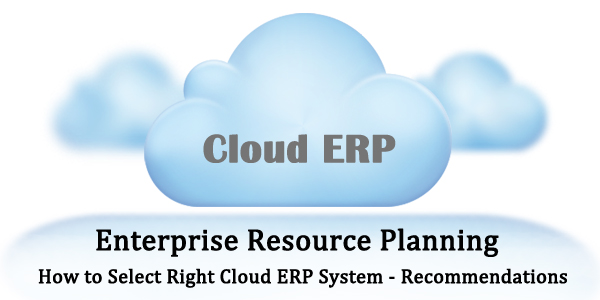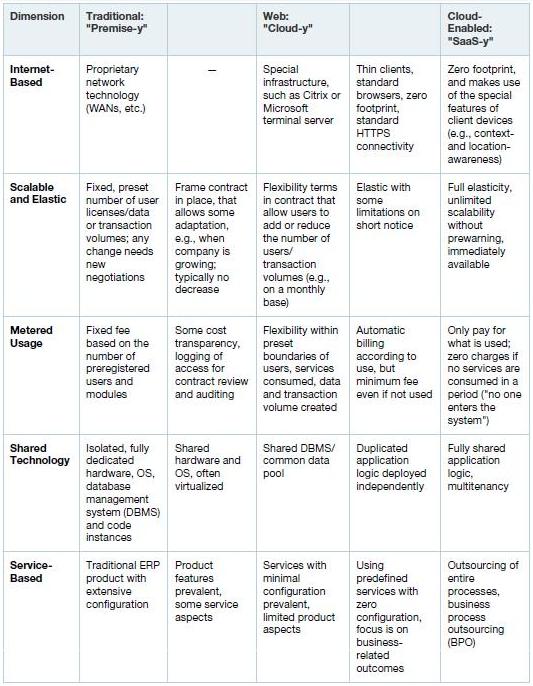Due to the increasingly used and popularity of cloud-based services, most of the ERP merchants now tends to provide a cloud-based ERP; however, people are still not clear about “What exactly the Cloud ERP Means”. Many people think that the term “Cloud ERP” is same as “Software as a Service ERP”, but the truth is that it is far different from the Software as a Service ERP. In order to determine the cloudiness of the products offered in the market, the ERP managers from organizations need to evaluate several aspects of the cloud ERP options.
Key Challenges While Selecting the Cloud ERP
- Selection of a Cloud ERP system suitable for an organization is not as simple as it seems. There is a wide range of cloud characteristic from which an organization need to choose the best.
- It is highly important to understand the term “cloud” as the features offered by the vendor completely depends on it. The ERP options can range from hosting of an on-premises system, to private or public cloud networking, to multi-tenant or singe-tenant SaaS. Kindly, remember that according to Gartner, the multi-tenant SaaS ERP system is not a suitable option for every organization.
Recommendations for Selecting the Best Cloud ERP
- Evaluate the aspects and cloud characteristics of an ERP system to distinguish several offerings.
- Utilize the aspects mentioned in the content below to select the type of cloud ERP suitable to your requirements.
Introduction to ERP System
ERP software often called as “Enterprise Resource Planning” system is a business management software which is gaining a great value in industry especially with small medium enterprises (SMEs). An enterprise requires planning, resource allocation, and project goals in order to achieve success. The ERP software plays a very crucial role in driving businesses towards success. Its most important benefits to businesses is the integration, automation, and ability of creating processes that simply allow companies to know how efficiently they are working.
Today, in the industry, many merchants are selling their traditional ERP solution as a cloud ERP in order to promote it as being state-of-the-art. In some cases, instead of deploying them on-premises, they are being offered as hosted systems. Also, some vendors are promoting it by combining with application management services which are being sold under subscription license models. Though a combination of hosted ERP system with application management system can benefit in some ways such as outsourcing of operations and management of ERP system, however, when you speak about a solution associated with “cloud” it becomes really difficult to realize the characteristics like greater scalability, elasticity and automatic patches and upgrades. Without redeveloping and re-implementing the existing architecture and ERP system, it’s hard for the vendor to offer a cloud-native service with transparent, automatic patch management.
Three Most Common Types of Cloud ERP and Dimensions that Define Cloud ERP
Below are the three types of Cloud ERP being offered by vendors along with the dimensions in following tables:
- Hosted ERP System with Application Management Services as Traditional: “Premise-y” – This is a service based on on-premises systems and most of the time known as cloud ERP or on-demand ERP.
- Multitenant SaaS-ERP as Web: “Cloud-y” – This service is a kind of combination which is offered by most of the SaaS-ERP providers in the market.
- Fully cloud-enabled as Cloud-Enabled: “SaaS-y” – This combination of service is now being offered in the market by some cloud providers.
Table 1. Dimensions of Gartner’s Cloud Definition

Choosing the Best Cloud ERP System for Your Organization
Few of the aspect mentioned in the Table 1 and Table 2 are much relevant to the ERP systems. In order to choose the best suited and the most beneficial cloud ERP for your organization, you need to conclude the combination of characteristics listed in both the tables.
Scalability and Elasticity
Scalability and elasticity are the two most important features necessary for businesses to fulfill their strong seasonality requirements such as higher workload seen in e-Commerce stores before Christmas. The companies that develop faster through purchase can mainly benefit with the high scalability feature.
Recommendation: If your business workload is unpredictable in the ERP system, then definitely you need to think beyond the traditional hosting, and should occupy dedicated resources. You should look for a service that will dynamically scale up and down the resources, with low latency.
Metered Usage
The metered usage is much related to elasticity, however not identical. The metered usage basically involves of the financial aspects. There is a service known as “Shelfware as a Service”, a concept where the users have to pay for an application subscription. These subscription agreements are usually based on a fixed number of users, where the users don’t know what services have been dubbed as “Shelfware as a Service”.
Recommendation: Well, most of the businesses and organizations know their consumption model, so selecting a model based on a limited number of users would be beneficial for them. However, an organization that requires high elasticity need to make sure that the contract includes a clause which will enable them to pay only for the services they have consumed in the given period of time. It would be better to avoid the “Shelfware as a Service” model.
Shared Technology
It is common that the sharing of various things occur on almost each layers of the technology heap. All of the hosting data centers share a few things like buildings, electrical supplies and air conditioning systems. There are many such providers who provides virtualized servers that allows apps to share the hardware, leading crash of one physical server affecting multiple ERP instances.
On the other hand, it is possible to share the DBMS; however, it can also negatively affect the performance of ERP instances, even if the organization keeps the data in different database schemes. Certainly, if the database tables are shared, there will be a logical partition which most of the times is supported by the encryption between multiple clients’ data.
Recommendation: The organizations should decide which level of data and application they would like to share. Remember that, the more the infrastructure is shared, the risk of failure increases and will get more potential for systems to affect each other in a negative way.
License Types
Definitely, a combination of a traditional perpetual license with hosting and application management services can be good, however, if the subscription model is used for years, the total cost may get higher than an initially purchased license. Another possible option would be to utilize the subscript model for temporary usage such as for upcoming divesture, when there’s a higher requirement of elasticity or it’s impossible to use the capital expenditure.
Recommendation: Businesses can evaluate the TCO model for the expected time of their ERP software for various license types, including the upgrades and replacement of hardware. After then, kindly choose the most suitable license type based on the requirements or alternatively a subscription license can be used while for the implementation and deployment phases, however, when the requirement is finished, simply switch to a perpetual license. This way business can avoid the “shelfware” for the users that were never deployed.
Application Management Services
Well, when you talk about SaaS-ERP, it is SaaS providers responsibility to take care of the operation and management of the service. However, when you say Hosted Cloud ERP, all the services under the solution such as Backup and DR, current operations and system monitoring, patches and upgrades are offered as extras. The application maintenance services usually includes of corrective, adaptive, preventive or perfective services.
It may be possible, that in future the new solutions might involve the multi-tenant SaaS-ERP systems in order to evaluate and enhance “application maturity” via business-related application performance monitoring.
Recommendation: Evaluate the level of service you need for your organization. There are some cases, where a third party provider can offer you such management services, and operation of the system in your name.
Location of Data and Processing
It is possible that a vendor may provide you a cloud ERP from a data center without knowing its location. In such a case, the provider can change the location anytime depending on the load balancing and availability of the data centers and the connectivity offered. It is too hard for an end user to know the exact physical location of the data. Such conditions can pose issues in various industries or in public sector institutions.
Recommendation: While contracting with the cloud ERP provider, make sure to include the terms of having control over the physical location and processing of your data. Also, ensure to ask under which clause the personal information will be handed over to the law enforcement agencies, tax and financial auditors.
Convenient to Toggle to a Different Solution
In the case of on-premises, users toggling a different solution, the data migration is entirely left to users. While, if you go for new solution, the provider may offer you some tools and services to migrate your data, however, the attempt to toggle systems is similar, whether it is an on-premises or cloud ERP.
When it comes to cloud environment, it becomes more critical than with an on-premises system, as in cloud the users rely more on the cloud providers. Additional issues may occur, as the former provider has complete control over your entire system. Especially, when it is about losing an existing good paying customer, most of the providers are unwilling to show support and sometimes restricts users from accessing their data, causing the loss of data.
Recommendation: In case, if you want to terminate or switch your web hosting provider, make sure to include a term in your contract that getting the required level of access to your data, code additions, etc…
Impact over Changes to the Software, Including Upgrades
Usually, when it comes to traditional on-premises deployment, all the changes are completely under the licensee. SaaS-ERP is totally opposite to the traditional on-premises. Here in SaaS-ERP solution, only the provider has the rights to decide what changes to apply and when to deploy the new features to a client’s system. Many ERP vendors and productivity tools provider such as Google exists, who can deploy the changes literally within a night.
Recommendation: When deploying a SaaS-ERP, simply create a wide-range of sets of test data and automatic testing routines that offers an ability to recognize possible bugs in the next version. You may then use these test results to make a decision on whether you want to deploy or postpone the upgrade until the next version is released.
Information Security Level of ERP System
Regarding the information security level, it is important to make sure the ERP system and its data is completely secured. When evaluating the security of a cloud hosting provider, remember that usually, a professionally managed cloud data center has the best security standards implemented than an on-premise have. Ensure that the provider guarantees that their systems are well tested for security vulnerabilities and meet with the legislation for all the countries where the data is or will be hosted and processed.
Based on the above Gartner’s Guidelines and Recommendations, ERP managers can select the right cloud ERP that best suits to their organizations.

